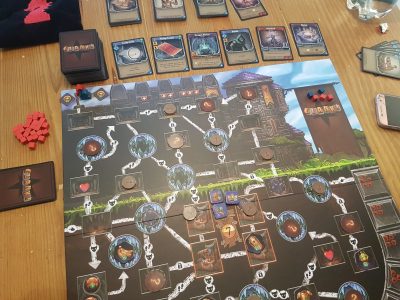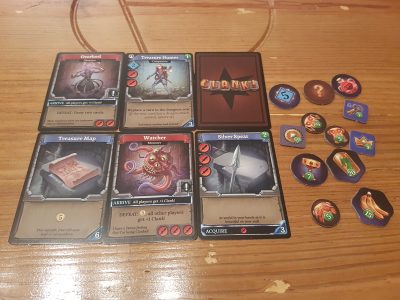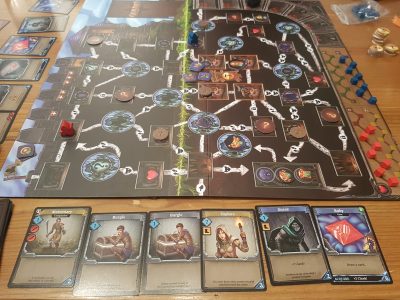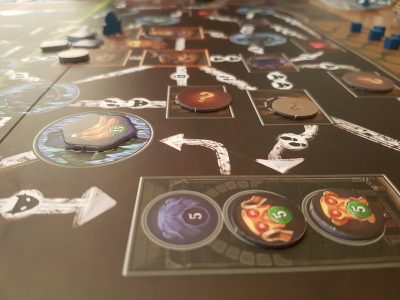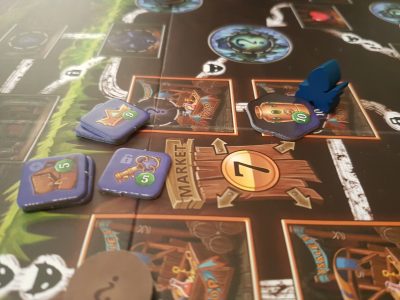Clank! is a deck building, dungeon themed, adventure game for 2 – 4 players from designer Paul Dennen. The challenge is a simple one: improve your deck, grab one of the dragon’s Artefacts and get out of there… or at least above ground before passing out from lack of health. Throughout the journey players will be joined by companions, attacked by the dragon, find plenty of loot and maybe escape alive, which bags the player some bonus points. Before I get carried away let’s find out how to play!
Set up is all straight forward, though does take a few minutes. This is mostly due to the number of cards to shuffle, tokens to place and colourful clank cubes/meeples to pass out. Two rows of cards will form Dungeon Rows at the side of the board. The top row is always the same and contains piles of Explore, Secret Tome and Mercenary cards alongside a single Goblin card. The row below is made of random cards from the shuffled Dungeon deck. These can contain new cards to buy in the form of companions, instant-use and permanent items and dastardly monsters to defeat.
Each player will receive a hand of 10 very basic starting cards, to give them initial deck to play with. On a turn a player will draw the top five cards from their deck and play them in whatever order they wish. If their deck has less than five cards, after drawing all possible cards the player shuffles their discard pile and then continues to draw to the 5-card hand size. Cards come with three main attributes Boots, Skill and Swords, each shown by symbols to be instantly recognisable.
Skill points are utilized for acquiring new cards. Each card on the Dungeon Row has a cost denoted at the bottom, as well as the card’s effects and attribute symbols clearly on it. Players buy these cards to upgrade their decks. New cards are placed on top of their individual discard pile until the player needs to shuffle it to make a new draw pile. While the Dungeon Row has a random distribution of 6 cards there is always something good due to the 3 consistent and decent Explore, Secret Tome and Mercenary cards.
When a card is brought it could come with a one-time acquire power, some of these are beneficial such as giving health while others force the player to place clank onto the banner (more on clank in a bit!). At the end of each players turns if a card from the main Dungeon Row has been purchased then it is replaced by the top most Dungeon deck card. Some of these will have Arrive abilities which are often not good for any player and other even have the Dragon’s symbol. Not matter how many Dragon symbols appear the dragon attacks.
At this point all clank cubes are taken from the banner and placed into the dragon bag. Several cubes are pulled from the bag, each cube deals damage to the player the coloured cube represents. The number pulled from the bag is determined by the dragon’s position on its tracker and addition cubes are pulled if any of the Dungeon Row cards have a Danger attribute. Usually 3 or 4 cubes are pulled and at the start chances are low that any player will be hit as black dragon cubes are placed in the bag that don’t hurt anyone. As the game progresses the black cubes dwindle and the dragon damage output to players increases.
Some cards, mostly weapons, will have Sword symbols. These can be utilized to fight monster in the Dungeon Row which offer rewards such as gold. Gold can then be used on another turn to purchase items from the market or kept for victory points. The market has a couple of useful items: keys, which allow the owner to pass through locked routes, and backpacks, that allow an additional Artefact to be obtained.
The final main symbol is Boots, which are simply spent to move from room to room. To make moving around the dark depths of the dungeon, both above and below ground, that bit more dangerous there are three ways that Clank! slows players down. Some paths between rooms have boot symbols; for each of these symbols players must spend an additional boot symbol to move through the corridor. Monster symbols will cause a player to lose one health unless they spend a Sword symbol from their cards. Last but not least is the lock symbol which blocks the route unless the player has brought a key from the market. These combine to make moving around a tricky task full of potential risks. To make matters worse there are plenty of Crystal Caves which stop players dead in their tracks, even if they have unspent Boots, and one-way tunnels to dwell on when planning where to go.
Clank! is a risky commodity to deal with when playing cards. One of the basic cards Stumble simple generates +1 clank, which isn’t great. Later on, cards acquired from the Dungeon Row will also have clank conditions. Cards like Move Silently allow you to remove 2 clank made at any point that turn or previously, while Swagger will see you earning 1 Skill for each clank you make that turn. It is all about the trade off of a quick gain against reducing your odds of getting inevitably hit by the dragon and losing health.
When players enter certain rooms, they may encounter major or minor secrets. Secrets that players come across on their journey have a range of abilities such as: immediately playing 3 more cards, gaining gold, regenerating health or moving an addition boots worth of movement. There are plenty of these abilities and this adds in another element of randomness, one that makes sense in the lore of the game of exploring the unknown dungeons. They do encourage players to take wiggly routes through the dungeon too as they are mostly all positive. One other item that plays can encounter are the shiny Artefacts that they are after. When players enter an Artefact room the can choice to pick it up if they have space.
So, you have managed to charge into the depths of the dungeon, obtain a high scoring Artefact, visit the market, take out a range of monsters and pesky goblins. Now your task is, if you think you’re doing better than your competition, to get out alive. To get out of the dungeon players must get all the way back to the starting location. If they do they are awarded a 20-point bonus. As soon as someone escapes or is killed the countdown starts.
Everyone else now has 4 turns to get at least above ground. Each turn after the first player finishes or dies, instead of having a turn their meeple is moved along the game end tracker causing the dragon to attack, more ferociously each time, until the 4th attack sees everyone left inside become unconscious. Those above ground get saved by local villagers, whereas those below are knocked out of contention. Then add up points earnt from cards, artefacts and tokens to find out whom is the best adventurer!
Player elimination is a bit of a mood killer if it happens too early in a game, though it then creates a mass dash to get above ground. If it occurs early on it just cuts the game in half, as it results in a game ending countdown to dragon made death. Thankfully, it often seems to occur at the end of the game as someone reaches the exit. Either way if a player is eliminated they will only be missing a maximum of 4 turns until the game ends, so not much time is wasted.
Card counting is, as with many deck building games, a potential issue to some and a potential bonus to others. You know at some point when drawing cards X card is going to come up in your hand. If like me you are quite good at remembering what you’ve played at some point it is more than possible to determine when at the end of the draw deck what you’ll be getting. This comes more naturally to some than others, and whether it is a skill could be debated for a long time. Either way it is something to bear in mind when playing, it can significantly help decisions of where to end movement for future turns if you can determine what you’re likely to pick up next turn.
When only two players are venturing in Clank! The market has ample supplies. As the player count increases players will have to get there fast to secure the item they want. For example, there are only two keys available for purchase. In a four-player game at most only 50% of the players will be able to use the locked routes. This is just something worth watching out for when finding the player count for you.
With less players the board only slightly changes as less Artefacts are placed onto the board. At the full player count of 4 all Artefacts are in play and are placed on their pre-defined board locations. As the player count drops 1 Artefact is removed randomly per absent player. This is one of the reasons why I prefer the full player count of 4. With 2-players, less so with three, players can run into the issue where a part of the board has little value, with no Artefacts available. It will still have major and minor secrets but it is rarely worth venturing off just for these, without a bigger payday of an Artefact along the way.
The start of Clank! is slow, especially with new players. Starting off the deck allows little movement, no combat potential and pitifully little skill points to spend in the store. This is a common issue I have with Deck builders that it is only once you have the ball rolling that the gameplay flows and different strategies become available. It would have been nice to see maybe one of the ten starting cards have some decency to it though, even if it was at the expense of a more negative card than Stumble. Countering this is the fact the slow-paced start helps new players, more so if it is their first deck builder, be inducted into the world of Clank! and its large ruleset.
Lastly, it would not be fair to Clank! to pass up the opportunity to mention the games artwork. It is stunning. Each unique card has its own image that not only all fit in the style and theme of the game but also help the game to shine. The same love and attention cascade from the cards onto the game board which is kept clean and clear so there is no confusion. A lot of games could learn from Clank! how to pull off an all-round excellent visual package.
There is quite a bit going on in Clank! rule wise. Mostly these are fairly intuitive and things start to become more natural to players after only a turn or two. From then on, the gameplay flows and the fun ramps up. Acquiring a few better cards from the Dungeon Row builds up your deck slowly but as with many deck builders allows for a sense of real progression throughout the game. There is plenty of depth to Clank! other than the obvious deep dungeon to explore. Players will have to adapt to the cards that are drawn from their deck, look to minimise clank produced and determine the best route around the dungeon. All in all, this is a great dungeon raiding game that shows off the very best of deck building, earning Clank! it’s place on my gaming shelf!
[Editor’s Note: Clank! was provided to us by Esdevium Games for review purposes. The game is currently available on 365 Games for £42.99. It is also available from local UK board game stores, find your local store here]


